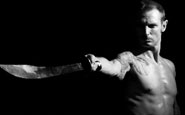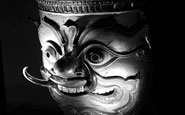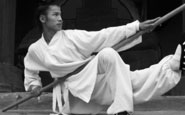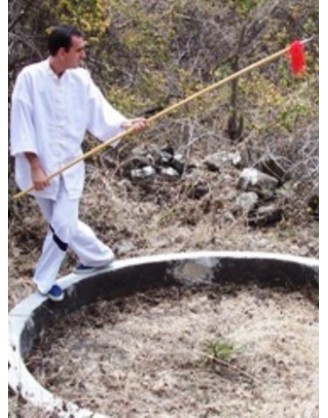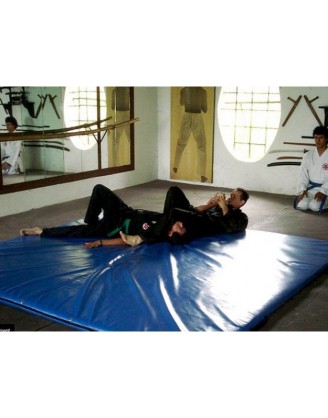Aikido

Aikido is a modern martial system of Japanese derivation, developed by founder Ueshiba Morihei (1883-1969) over the course of his lifetime. Aikido employs the redirection of an attacker’s energy (or ki) into a variety of holds, locks, and projections, and is probably best known for an exclusive focus on defensive maneuvers and for its unique martial philosophy.
The principle of aiki, a method of defeating an attack through harmonizing with rather than directly opposing the aggressive motion, predates aikido, and it found expression in many of feudal Japan’s sophisticated martial systems. Aikido’s most direct predecessor art, Daito-ryu jUjutsu, laid particular emphasis on this strategy and on the techniques that employed it most efficiently (many of which would be seen in some form in Ueshiba’s modern budo [“martial way”]). Indeed, Ueshiba was first known as a high-quality Daito-ryu instructor, and he used the terms jujutsu and aikibudo for his art through his early decades of teaching.
Among the schools derived from Ueshiba’s pioneering efforts, patterns in technique and philosophy correlate closely with teachers’ historical associations with Ueshiba and, later, with Tohei. Prewar students of aikibudo retained an emphasis on atemi (striking) and generally expressed indifference (at best) about the well-being of an attacker as a result of the defense, resulting in a flavor closer to aiki-jujutsu than to the peaceful art developed by Ueshiba in his later years.
The philosophy of aikido correlates closely to the art’s techniques, and though even the orthodox branches of aikido are not in complete agreement on either, some generalizations can be made. In aikido an attack is not responded to with a counterattack, in the classic rhythm of strike, block, return strike; rather, the practitioner seeks to allow a committed attack to pass by, and then to exploit the attacker’s resulting imbalance. Thus both the initial attack and forceful opposition to such an attack are characterized as futile and maladjusted endeavors, out of harmony with the universe; an aikido approach to conflict (physical or otherwise) begins with searching for a way to “blend with” rather than oppose aggressive action. From this point a physical application normally proceeds to projection or control of the attacker, usually with an emphasis on preventing any (or at least any serious) injury to the attacker. The curricula of many aikido schools lack or de-emphasize hand strikes, and most lack kicking techniques, although defenses against both are practiced.
Manipulation of the ki energy of both the attacker and defender is implied even in the art’s name, but interpretation of the nature of ki, and its proper manipulation, vary. Aikido is often classed among the “soft” or “internal” martial arts, like the Chinese taijiquan (tai chi ch’uan), xingyi-quan (hsing i ch’uan), and baguazhang (pa kua ch’uan ), and an emphasis on breathing exercises and ki exercises (meant to improve a practitioner’s control of his own energy) is common. Aikido schools descending from Tohei Koichi’s tradition even maintain separate ki rankings (related but not identical to the student’s aikido куй or dan rank, discussed below) based on the student’s mastery of ki concepts and applications, including kiatsu, a healing method practiced by Tohei Koichi. Interpretations of ki in aikido range from the mystical (complete with tales of miraculous feats by Ueshiba Morihei) to the utilitarian and prosaic.
Uses of the bokken (a wooden representation of the Japanese sword) and jo (a four-foot staff) are common auxiliary training methods in aikido, reflecting the elements of timing, distance, and initiative that aikido and its predecessor arts took from the armed disciplines of the samurai. In general, the use of these weapons in aikido training is undertaken for the illustration and practice of aikido principles, rather than for the sake of combat-oriented proficiency with the weapons themselves, although weapon-handling methods taught in various aikido schools are widely divergent. Disarming and weapon-retention techniques are often included in this practice and related to similar unarmed procedures in other arts.
The tanto, a wooden replica of a Japanese dagger, is also maintained as a training tool, although unlike the other wooden weapons it is rarely considered from the wielder’s perspective. Instead, the tanto is used exclusively for the practice of disarming techniques. (An exception to this occurs in Tomiki Aikido dojo, which engage in a competitive sport revolving around tanto offense and defense. In their matches, a rubber tanto may be used by the offensive player to score, while successful defense yields the defender both points and the tanto.) An aikido approach to conflict begins with searching for a way to “blend with’ rather than oppose aggressive action.
Aikido training is usually centered on partner practice, in which students alternate practicing the roles of uke (the attacker and the one who ordinarily takes a fall) and nage (the defender). Other aikido training methods may include aiki taiso (specialized calisthenics for the application of energy in the aikido manner), weapon forms, sword and staff disarms and sword and staff retention techniques, kokyu ho (“breath power exercise") breath and balance training, and a multiple-attacker exercise called randori. In aikido’s randori, a single nage uses aikido protective strategy and techniques against a number of attackers, who may or may not be limited in the methods that they are allowed to employ against nage. Randori encourages versatile, decisive movement on nage’s part and rewards swift and efficient unbalancing techniques rather than involved control holds or throws. It is often a prominent feature of aikido rank tests.
Ranking in most aikido dojo is based on a belt system derived from the one originated for sport judo. A variety of kyu ranks lead up to certification as sbodan (first dan, usually translated as first-degree black belt), usually designated by a black belt. Dan ranks proceed from this important step, and upper ranks may vary according to the particular affiliation of the dojo. The hakama, a traditional divided-skirt garment, is seen in many aikido dojo, often as a rank designator similar to the black belt. Ueshiba considered the wearing of this garment to be a matter of basic courtesy for students of all ranks, but modern dojo traditions vary widely, and the wearing of the hakama may be required for all students or restricted to particular students according to local custom.
With its lack of tournaments and its unusual philosophical emphasis, aikido has spread through different venues than other popular martial arts. Seen from its inception as an art with broad philosophical implications and many applications outside the realm of physical conflict, aikido has attracted more academic interest than most martial arts and has been advocated in adapted forms as a paradigm in psychology, business, and conflict management. The physical effectiveness of aikido, along with its humane priorities, has held considerable appeal for law enforcement applications as well, and Shioda Gozo’s Yoshinkan Aikido (a style heavily influenced by prewar aikibudo) was chosen for the training of the elite Tokyo police. However, the art has generally had a low media profile, with the exception of the film career of senior aikido practitioner Steven Seagal. (His movies have featured a great deal of aikido-influenced fight choreography.)
Training in aikido is today readily available in much of the world, thanks in part to deliberate efforts by Ueshiba to establish his art worldwide as a way of promoting his ideals.

